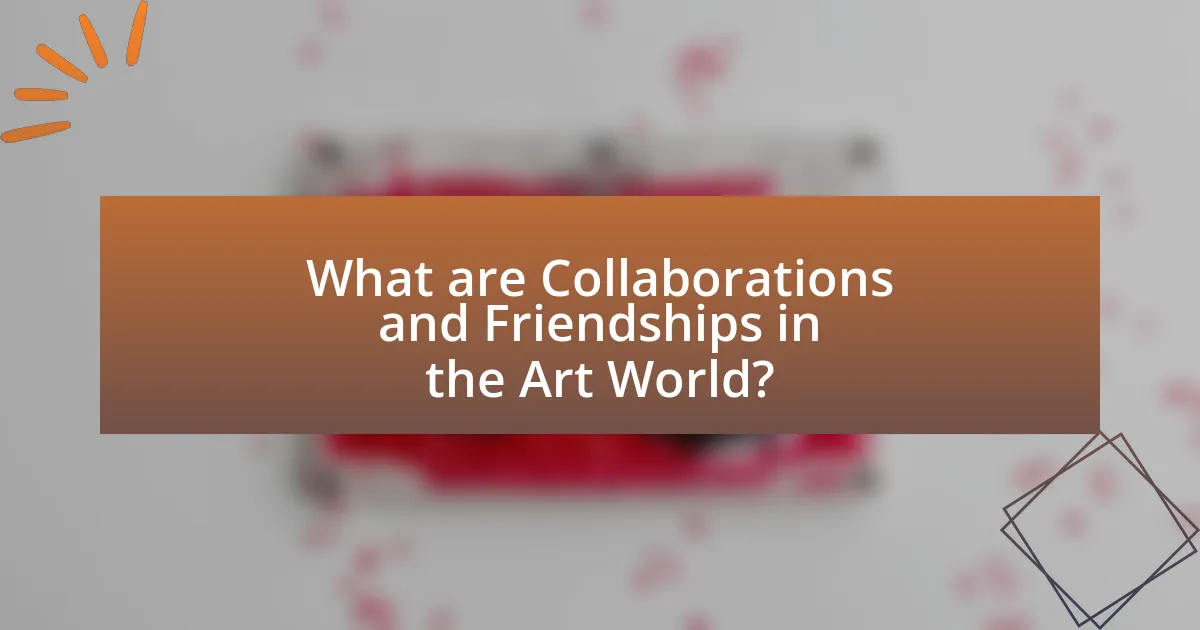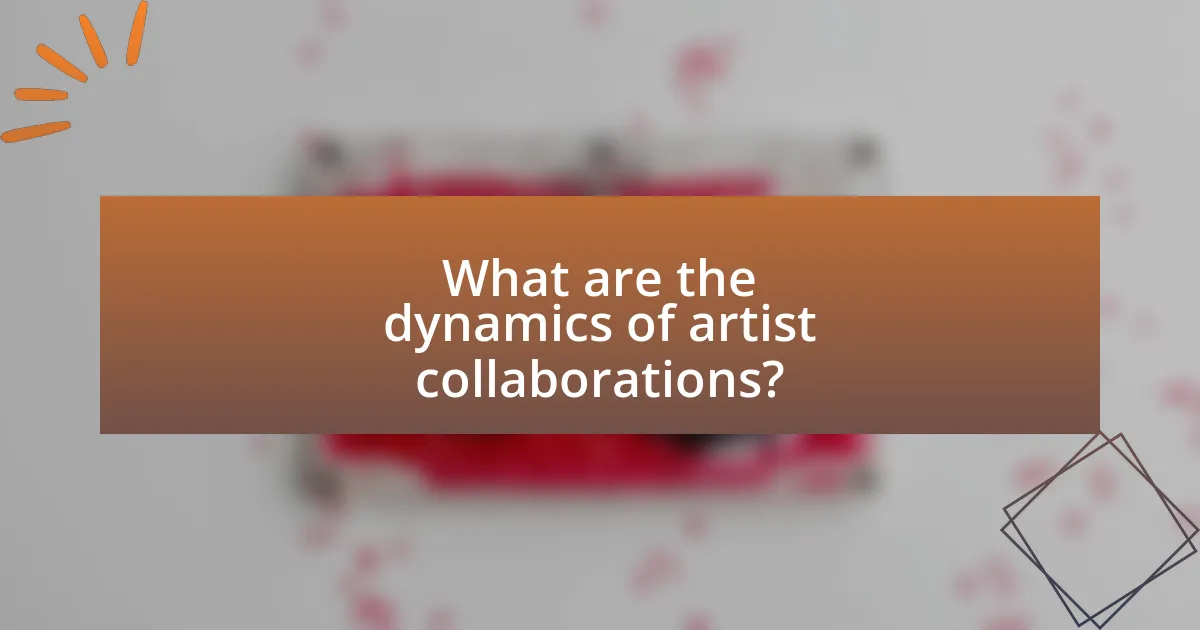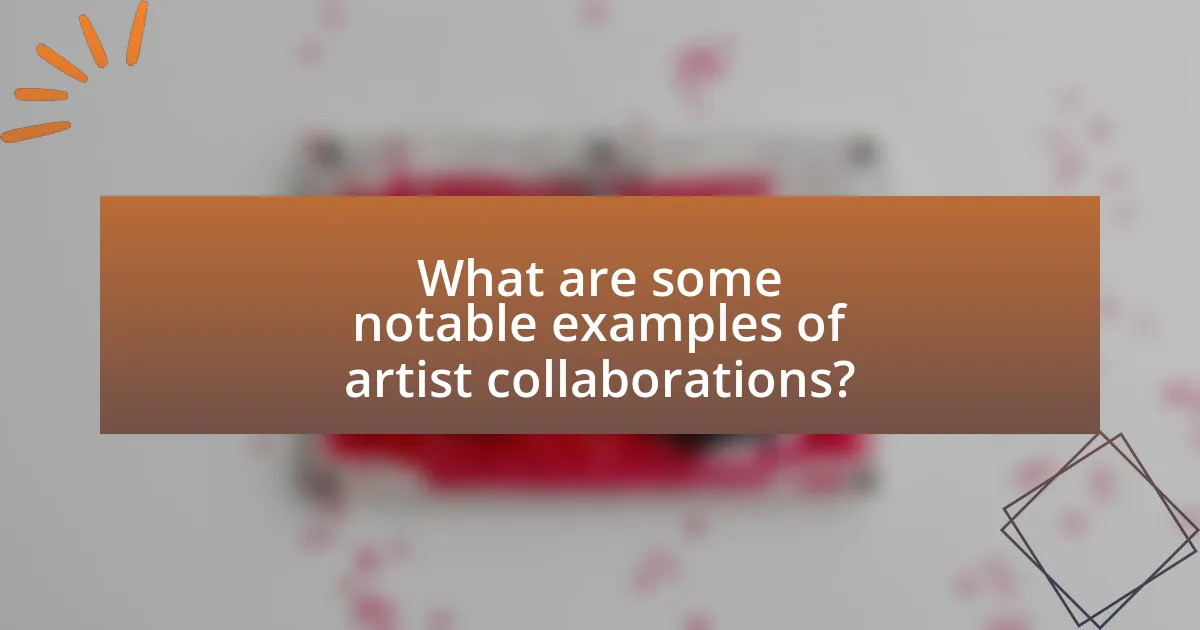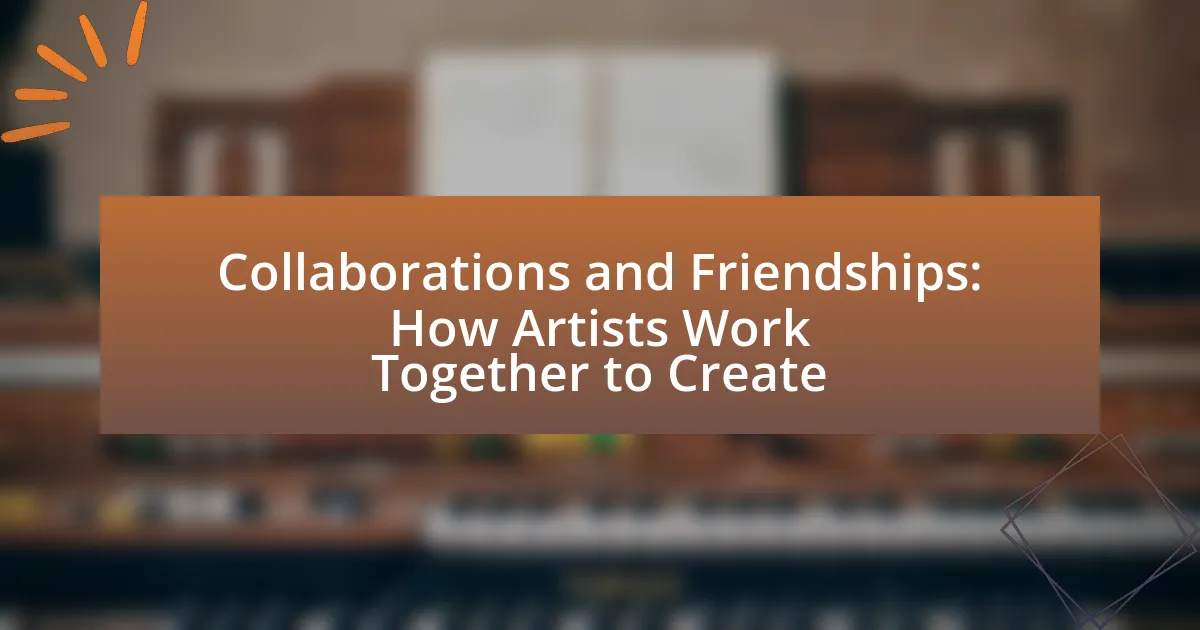Collaborations and friendships in the art world are essential partnerships that enhance creativity and lead to innovative artistic expressions. This article explores how these collaborations foster artistic growth, expand networks, and improve skill sets among artists. It examines various forms of artistic collaborations, the influence of personal relationships on the collaborative process, and the challenges artists face when working together. Additionally, it highlights notable examples of successful collaborations and discusses the impact of modern technologies and emerging trends on collaborative art practices. The article emphasizes the importance of clear communication, mutual respect, and defined roles in achieving successful artistic partnerships.

What are Collaborations and Friendships in the Art World?
Collaborations and friendships in the art world refer to the partnerships and personal relationships that artists form to enhance creativity and produce collective works. These collaborations often lead to innovative projects, as artists bring diverse perspectives and skills together, resulting in unique artistic expressions. Historical examples include the collaboration between artists like Andy Warhol and Jean-Michel Basquiat, which merged their distinct styles and ideas, creating impactful art that resonated with contemporary culture. Such partnerships not only foster artistic growth but also build supportive networks that can influence an artist’s career trajectory.
How do collaborations enhance artistic expression?
Collaborations enhance artistic expression by combining diverse perspectives, skills, and ideas, leading to innovative outcomes. When artists collaborate, they draw from each other’s strengths, resulting in a richer creative process. For instance, the collaboration between musicians and visual artists often leads to multimedia projects that push the boundaries of traditional art forms. Research shows that collaborative art projects can increase creativity and motivation among participants, as seen in studies conducted by the National Endowment for the Arts, which highlight how teamwork fosters a sense of community and shared vision. This synergy not only broadens the scope of artistic expression but also allows for the exploration of new techniques and concepts that may not emerge in solitary work.
What are the different forms of artistic collaborations?
Artistic collaborations can take various forms, including interdisciplinary collaborations, co-creation, collective art projects, and mentorship. Interdisciplinary collaborations involve artists from different fields, such as visual arts and music, working together to create a unified piece. Co-creation occurs when artists jointly develop a work, sharing ideas and responsibilities throughout the process. Collective art projects engage multiple artists in a single initiative, often resulting in community-driven works. Mentorship involves experienced artists guiding emerging talents, fostering skill development and creative exchange. Each form enhances creativity and broadens artistic perspectives, demonstrating the diverse ways artists can collaborate.
How do friendships influence the collaborative process?
Friendships significantly enhance the collaborative process by fostering trust, open communication, and a shared sense of purpose among collaborators. When individuals have established friendships, they are more likely to engage in candid discussions, share creative ideas freely, and provide constructive feedback without fear of conflict. Research indicates that teams with strong interpersonal relationships tend to exhibit higher levels of creativity and innovation, as evidenced by a study published in the Journal of Creative Behavior, which found that collaborative groups with pre-existing friendships generated more original ideas compared to those without such relationships. This supportive environment encourages risk-taking and experimentation, essential components for successful artistic collaboration.
Why are collaborations important for artists?
Collaborations are important for artists because they foster creativity, expand networks, and enhance skill sets. When artists collaborate, they combine diverse perspectives and techniques, leading to innovative works that may not have been possible individually. For instance, a study by the National Endowment for the Arts found that collaborative projects often result in higher-quality outcomes and increased audience engagement. This synergy not only enriches the artistic process but also helps artists reach new audiences, thereby increasing their visibility and opportunities in the art world.
What benefits do artists gain from working together?
Artists gain several benefits from working together, including enhanced creativity, resource sharing, and increased exposure. Collaborative efforts often lead to the fusion of diverse ideas and techniques, which can result in innovative artistic expressions that may not emerge in solitary work. For instance, a study published in the Journal of Creative Behavior found that collaborative environments significantly boost creative output by allowing artists to build on each other’s strengths and perspectives. Additionally, artists can share resources such as materials, studio space, and networks, which can reduce costs and expand opportunities for showcasing their work. This collaborative approach also increases visibility, as joint projects often attract a wider audience and media attention, ultimately benefiting all artists involved.
How do collaborations impact the art community as a whole?
Collaborations significantly enhance the art community by fostering innovation and expanding creative boundaries. When artists work together, they combine diverse perspectives and skills, leading to unique artistic expressions that might not emerge in isolation. For instance, collaborative projects like the “The Artist’s Project” in 2019 showcased how partnerships between visual artists and musicians resulted in interdisciplinary works that attracted broader audiences and increased engagement within the community. This synergy not only enriches the individual artists’ practices but also strengthens community ties and promotes cultural exchange, ultimately contributing to a more vibrant and dynamic art scene.

What are the dynamics of artist collaborations?
Artist collaborations involve the interaction and synergy between multiple creators to produce a unified artistic work. These dynamics can include complementary skill sets, shared creative visions, and the blending of diverse perspectives, which enhance the overall quality and innovation of the final product. For instance, a study published in the Journal of Creative Behavior highlights that collaborations often lead to increased creativity and problem-solving capabilities due to the pooling of different ideas and experiences. This collaborative process can also foster a sense of community and support among artists, further enriching their individual practices and the collective output.
How do artists choose their collaborators?
Artists choose their collaborators based on shared artistic vision, complementary skills, and mutual respect. This selection process often involves evaluating the potential collaborator’s previous work, creative style, and ability to contribute meaningfully to the project. For instance, artists may look for individuals who have successfully collaborated in the past or those who bring unique perspectives that enhance the overall creative output. Additionally, personal relationships and trust play a significant role, as artists often prefer to work with individuals they know and respect, which can lead to more productive and harmonious collaborations.
What factors influence the selection of collaboration partners?
The selection of collaboration partners is influenced by factors such as shared vision, complementary skills, and mutual trust. A shared vision ensures that all parties have aligned goals and objectives, which is crucial for successful collaboration. Complementary skills allow partners to bring diverse strengths to the project, enhancing creativity and problem-solving capabilities. Mutual trust fosters open communication and collaboration, which are essential for navigating challenges and achieving desired outcomes. Research indicates that successful collaborations often stem from these foundational elements, as they create a conducive environment for innovation and productivity.
How do personal relationships affect collaboration choices?
Personal relationships significantly influence collaboration choices by shaping trust, communication, and mutual understanding among collaborators. When artists have established personal connections, they are more likely to engage in open dialogue, share creative ideas freely, and navigate conflicts effectively. Research indicates that collaborative projects often thrive in environments where personal rapport exists, as seen in studies highlighting that teams with strong interpersonal relationships report higher satisfaction and productivity levels. For instance, a study published in the Journal of Creative Behavior found that artists who collaborated with friends experienced enhanced creativity and innovation compared to those who worked with strangers. This evidence underscores the importance of personal relationships in fostering successful collaborative efforts.
What challenges do artists face in collaborations?
Artists face several challenges in collaborations, including differing creative visions, communication barriers, and unequal contributions. Differing creative visions can lead to conflicts over artistic direction, as each artist may have unique ideas and styles that may not align. Communication barriers often arise from misunderstandings or lack of clarity, which can hinder the collaborative process. Additionally, unequal contributions can create tension if one artist feels they are doing more work than the other, leading to resentment. These challenges can significantly impact the success and harmony of collaborative projects.
How can differing artistic visions create conflict?
Differing artistic visions can create conflict by leading to disagreements over creative direction and interpretation. When artists collaborate, their unique perspectives and styles may clash, resulting in tension regarding the final outcome of a project. For instance, in the film industry, directors and producers often have differing visions for a movie, which can lead to disputes over casting, script changes, and overall tone. Historical examples include the conflicts between directors and studios, such as the disagreements faced by Francis Ford Coppola during the production of “Apocalypse Now,” where his vision for the film was at odds with studio expectations. Such conflicts can hinder collaboration and affect the quality of the final work.
What strategies can artists use to overcome collaboration challenges?
Artists can overcome collaboration challenges by establishing clear communication, setting defined roles, and fostering mutual respect. Clear communication ensures that all parties understand expectations and objectives, which minimizes misunderstandings. Defined roles help each artist know their responsibilities, reducing overlap and conflict. Fostering mutual respect creates a positive environment where diverse ideas can flourish, leading to more effective collaboration. Research indicates that successful collaborations often stem from these foundational strategies, as they promote a cohesive working relationship among artists.

What are some notable examples of artist collaborations?
Notable examples of artist collaborations include the partnership between Andy Warhol and Jean-Michel Basquiat, which produced a series of works that blended their distinct styles and challenged contemporary art norms. Another significant collaboration is the musical partnership of Jay-Z and Kanye West on the album “Watch the Throne,” which showcased their combined talents and achieved critical and commercial success. Additionally, the collaboration between Beyoncé and Shakira on the song “Beautiful Liar” highlighted their vocal abilities and cultural impact, further solidifying their status in the music industry. These collaborations exemplify how artists can merge their creative visions to produce influential works.
How have famous collaborations shaped the art world?
Famous collaborations have significantly shaped the art world by merging diverse perspectives and techniques, resulting in innovative works that challenge traditional boundaries. For instance, the collaboration between artists Andy Warhol and Jean-Michel Basquiat in the 1980s produced a unique fusion of pop art and neo-expressionism, which not only redefined their individual styles but also influenced contemporary art movements. Additionally, the partnership of artists Christo and Jeanne-Claude, known for their large-scale environmental works, demonstrated how collaborative efforts can amplify artistic vision and engage public spaces, as seen in their installation “The Gates” in Central Park in 2005, which attracted millions of visitors and sparked discussions about art in public contexts. These collaborations exemplify how artists working together can create impactful, culturally relevant art that resonates with broader audiences.
What lessons can be learned from successful artist partnerships?
Successful artist partnerships demonstrate the importance of collaboration, communication, and mutual respect. These partnerships often lead to innovative outcomes, as artists combine their unique skills and perspectives to create something greater than their individual contributions. For example, the collaboration between musicians like Jay-Z and Kanye West on the album “Watch the Throne” showcases how blending different styles can result in critically acclaimed work, achieving over 1 million sales in the U.S. alone. Additionally, successful partnerships often involve clear roles and responsibilities, allowing each artist to focus on their strengths while supporting one another. This structured approach fosters creativity and enhances productivity, as seen in the partnership between artists Gilbert & George, who have worked together for decades, producing a cohesive body of work that reflects their shared vision.
How do these collaborations reflect cultural or social themes?
Collaborations among artists reflect cultural or social themes by merging diverse perspectives and experiences, which often highlight shared societal issues or cultural narratives. For instance, when musicians from different backgrounds collaborate, they may address themes such as identity, community, or social justice, thereby fostering a dialogue that resonates with a broader audience. A notable example is the collaboration between artists like Beyoncé and Shakira, which not only showcases their individual cultural heritages but also emphasizes themes of empowerment and unity among women. Such partnerships can amplify messages related to race, gender, and social change, making the art more relevant and impactful within contemporary society.
What role do collaborations play in contemporary art?
Collaborations play a crucial role in contemporary art by fostering innovation and expanding creative boundaries. Artists who collaborate often combine diverse perspectives and skills, resulting in unique works that challenge traditional notions of authorship and artistic practice. For instance, the collaborative project “The Obliteration Room” by Yayoi Kusama and the team at Queensland Art Gallery exemplifies how collective efforts can transform a space and engage audiences in interactive experiences. This approach not only enhances the artistic process but also encourages community involvement and dialogue, reflecting the increasingly interconnected nature of contemporary art.
How are modern technologies influencing artist collaborations?
Modern technologies are significantly enhancing artist collaborations by facilitating real-time communication and access to diverse tools. Digital platforms enable artists from different geographical locations to collaborate seamlessly, allowing for the sharing of ideas and resources instantaneously. For instance, software like Adobe Creative Cloud and collaboration tools such as Slack and Zoom have become essential in enabling artists to work together on projects without the constraints of physical distance. Additionally, social media platforms allow artists to showcase their work and connect with potential collaborators, expanding their networks and opportunities for joint projects. This shift towards digital collaboration has been supported by statistics indicating that remote collaboration tools have seen a surge in usage, with a 200% increase in video conferencing tools during the pandemic, highlighting the growing reliance on technology in creative partnerships.
What trends are emerging in collaborative art practices?
Emerging trends in collaborative art practices include increased use of digital platforms, interdisciplinary approaches, and community engagement. Artists are leveraging technology to collaborate across geographical boundaries, utilizing tools like virtual reality and social media to create shared experiences. Interdisciplinary collaborations are becoming more common, as artists from various fields—such as science, technology, and social activism—join forces to address complex societal issues. Additionally, there is a growing emphasis on community involvement, where artists work directly with local populations to co-create art that reflects their experiences and narratives. These trends highlight a shift towards inclusivity and innovation in the collaborative art landscape.
What practical tips can artists follow for successful collaborations?
Artists can achieve successful collaborations by establishing clear communication from the outset. Effective communication ensures that all parties understand their roles, expectations, and creative visions, which is crucial for a harmonious working relationship. Additionally, setting specific goals and deadlines helps to keep the collaboration focused and productive. Research indicates that collaborative projects with defined objectives are more likely to succeed, as they provide a roadmap for the artists involved. Furthermore, being open to feedback and flexible in adapting ideas fosters a creative environment where innovation can thrive. Studies show that collaborations that encourage constructive criticism lead to higher quality outcomes, as artists can refine their work through diverse perspectives. Lastly, building trust and mutual respect among collaborators enhances the overall experience, as artists feel valued and motivated to contribute their best efforts.
How can artists effectively communicate during collaborations?
Artists can effectively communicate during collaborations by establishing clear goals and expectations from the outset. This involves discussing the project’s vision, roles, and responsibilities to ensure all participants are aligned. Regular check-ins and open dialogue throughout the collaboration facilitate feedback and adjustments, fostering a collaborative environment. Research indicates that effective communication enhances creativity and productivity in group settings, as seen in studies by the American Psychological Association, which highlight the importance of clarity and mutual understanding in team dynamics.
What best practices should artists adopt to foster positive working relationships?
Artists should adopt clear communication, mutual respect, and collaboration as best practices to foster positive working relationships. Clear communication ensures that all parties understand expectations, deadlines, and creative visions, which minimizes misunderstandings and conflicts. Mutual respect involves valuing each other’s contributions and perspectives, creating an environment where everyone feels appreciated and motivated. Collaboration encourages the sharing of ideas and skills, leading to innovative outcomes and stronger bonds among artists. Research indicates that effective communication and respect are critical components of successful teamwork, as highlighted in studies on group dynamics in creative fields.
